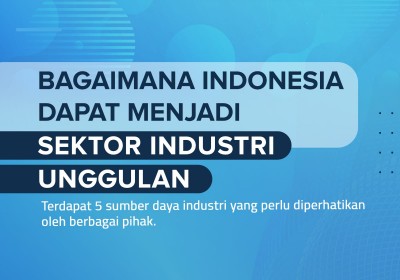Leading Industrial Sectors Prepare Strategies to Adapt to the Pandemic
July 08, 2021
JAKARTA – To foster leading industrial sectors, special attention must be given to the 5 crucial resources, by all stakeholders.
The first is human resources, and strategies on how to foster and develop various skill sets in various sectors. The second is natural resources, followed by technology and innovation (or entrepreneurship skills). The fifth is financial resources, of which Indonesia does not have a clear regulation for.
This concern is addressed by Bandung Institute of Technology (ITB) professor Dradjad Irianto during the Inspiring Session Road to Indonesia Development Forum 2021 (RIDF) webinar on Tuesday (29/6).
"The preconditions for a successful industry are: business certainty, an ecosystem tailored to the business climate, proper and clear standardization practices and fixing problems related to logistical ecosystems which are, currently, very weak," Prof. Dradjad said.
The cosmetics industry is one of Indonesia's leading industrial subsectors, as it can survive and adapt during the COVID-19 pandemic.
PT Martina Berto president director Bryan Tilaar says that his company aims to become one of the largest beauty companies in the world, by placing emphasis on research and development as part of their growth strategy. Their aim is to not only promote quality beauty products but to also be fiscally healthy, boast competitive workers and efficient technology, good governance and pushing into the international market.
For 2020-2021, Martina Berto's strategy is to have every one of its business become a profit center, where one business must not be dependent on another within the group and must therefore find clients outside of the Martina Berto business group.
"Our strategy after 2021 is to maintain and improve our business by focusing on makeup, skincare, haircare, jamu and extract products. We also plan to do more joint ventures and acquisitions," Bryan explains.
Martina Berto's approach is different from Procter & Gamble, who has a strategy that focuses on building up and maintaining their low-to-middle class, Asia-Pacific consumer base. Indonesia, with its consumptive low and middle classes, is a crucial market for the consumer goods company.
"We have and will continue to maximize our partnerships with local suppliers in various fields. Right now, almost all of our raw packaging material comes from local suppliers. And not only do they only supply the Indonesian operations, but many Indonesian packaging suppliers have also supplied for other P&G operations in the region. This is how we can keep Indonesia's small industries competitive in the international market," P&G Indonesia market planning director Amalia Dwi Putri said.
Meanwhile, on another side, the aviation industry is reeling from the heavy impact it took due to the COVID-19 pandemic, particularly its maintenance, repair and overhaul departments.
Before COVID-19, it was projected that the aviation industry and its supporting MRO sectors will experience positive performance for the next 10 years, especially in the Asia-Pacific region (4%). However, domestically, the absorption of the domestic MRO market is still less than 50%. Not to mention the global travel restrictions in place choking the aviation industry's mobility.
But in the pandemic, it is the MRO industry that is being hit the hardest due to the number of planes grounded.
"GMF Aeroasia has attempted to shift its focus from passenger travel to cargo. GMF managed to grow by 12% from 2019 to 2020 and rose by 32% from 2020 to 2021. Other methods that we're trying include focusing on private jet business, the defense industry and gas turbine production," PT Garuda Maintenance Facility (GMF) Aeroasia CEO I Wayan Susena said.
The same conditions were experienced by PT Pudak Scientific, a Bandung aircraft components company who are one of only 11 companies that are officially licensed to manufacture components in Indonesia.
"The impacts of COVID-19 have resulted in the number of planes delivered by manufacturers such as Airbus and Boeing to fall by 65%. This figure will return to normal by 2024 or 2025 at the soonest, and airlines will later place more emphasis on single-aisle planes and domestic routes to make up the costs," PT Pudak Scientific director Andreas Wangsanegara.
Indonesia's homework, added Andreas, is to implement quality standards, develop a different work culture, develop its STEM talents, and having the government provide added incentives such as tax holidays to prospective investors of the aviation industry.
Indonesia’s Research Institutions Supporting the Development of the Electric Vehicle Industry
Indonesian Muslim Fashion and Cosmetics IKMs Shine at Dubai World Expo 2020
Govt Steps Up UMKM Transformation Efforts in the Midst of Pandemic Slowdown
Govt Encourages Promotion of IKM Products in Digital Era
Government Begins Developing Maritime Training Center in Makassar
Tweets by IDDevForum
